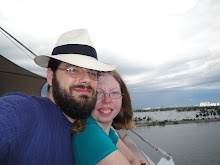Today is the 3rd annual Rare Disease Day. What is Rare Disease Day, you ask? It is a large event organized by EURORDIS in in an attempt to raise worldwide awareness for all rare diseases. Forty countries are participating this year (including the US). There are 7,000 rare diseases in the US. Combined these diseases affect at least 25 MILLION Americans. To learn more about rare diseases in general, go to the Children's Rare Disease Network.
In honor of this day, I have chosen to do a special blog entry to raise awareness. I will be talking about five diseases, all of which affects someone I know. If, at any time, you want to know more about any of these diseases, please feel free to comment or email me. Also, all headers are linked to pages where you can find more information.
Langerhan's Cell Histiocytosis (LCH)
LCH affects 1 in 200,000 children and 1 in 560,000 adults. 76% of all LCH patients are under 10.
Langerhan's Cell Histiocytosis is a disease that acts (and is treated) like a cancer yet is not classified as one. It caused by an overabundance of histiocytes (white blood cells) that accumulate in various areas of the body causing lesions and/or tumors to form.
Treatment for LCH includes chemotherapy, steroids, radiation, and, rarely, a bone marrow transplant. Despite treatment, the disease can and does prove fatal far more often than anyone cares to think about.
Hemophagocytic Lymphohistiocytosis (HLH)
HLH affects 1.2 in 1,000,000 people under the age of 15.
Hemophagocytic Lymphohistiocytosis can either be genetic or secondary to a virus. (Yes, something as simple as a virus can be the start of your nightmare!)
When a person gets sick their t-cells and histiocytes (i.e. their immune system) activate causing an inflammatory reaction in order to fight off the illness. In a person with HLH a defect in their immune system allows this inflammation to exist. Essentially, their body is attacking itself.
HLH is treated with immunosuppressants and chemotherapy. This treatment is usually followed with a bone marrow transplant in attempt to rid the body of the disease once and for all. Without treatment, HLH usually proves fatal within two months. Even with treatment, the disease can be fatal. Not only are immunosuppressants and chemotherapy risky, but bone marrow transplants can have long-lasting and potentially deadly complications.
Juvenile Xanthogranuloma (JXG)
JXG is probably the least researched of the histiocytic diseases. Not much is known about the disease.
It is unknown how many are affected by this disease because it is thought to be misdiagnosed most of the time. Since the disease can go into spontaneous remission, these patients may never get their true diagnosis.
Patients with Juvenile Xanthogranuloma often exhibit as a rash as their first (and sometimes only) symptom. However, JXG can also effect a persons eyes, brain, spinal cord, lungs, liver, spleen, and other organs.
Because so little is known about JXG, there is no standard treatment. Sometimes, nothing is done. Other times a patient may undergo surgery, chemotherapy, or even radiation. When it comes to JXG, nothing is "outside of the box."
Diamond Blackfan Anemia
Diamond Blackfan Anemia is characterized by the failure of a persons bone marrow to produce red blood cells. Most patients with Diamond Blackfan Anemia are diagnosed in the first year of their life.
Patients usually start treatment with regular blood transfusions (which results in a build up of iron in the body causing the need for chelation therapy). The goal is to get them old enough and healthy enough to start corticosteroid therapy in attempt to send the disease into remission. However, this doesn't always work and some patients go on to receive a risky bone marrow transplant.
According to the DBA Foundation, 40% of all DBA patients are transfusion dependent, 40% are steroid dependent, and only 20% are in remission from the disease.
Fanconi Anemia (FA)
Fanconi Anemia is a genetic disorder that leads to bone marrow failure. The average life expectancy of a Faconi patient is 24.7 years.
Many people with FA will develop Acute Myeloid Leukemia (AML) at an early age. Even if the person, doesn't develop AML it is extremely likely they will develop some form of cancer early in their life.
In addition to the cancer risk, patients with Fanconi Anemia may have thumb and arm abnormalities, skeletal abnormalities, kidney problems, a small head or eyes, gastro-intestinal issues, small male reproductive organs, and/or heart defects.
Medically, doctors tend to work on managing the symptoms until the patient is 8-12 years old when the child undergoes a bone marrow transplant. A successful bone marrow transplant will cure the blood problem but the patient will still be at an increased risk for cancer.
How you can help:
Share your new knowledge. Share the links I have provided today. Write your congressman asking for government funding to save the lives of these children.
Donate blood and platelets at your local Red Cross or hospital. Sign up to be a marrow donor. Host a marrow drive to sign others up!
You can even donate monetarily at any of the sites for research.
Monday, February 28, 2011
Subscribe to:
Post Comments (Atom)





No comments:
Post a Comment